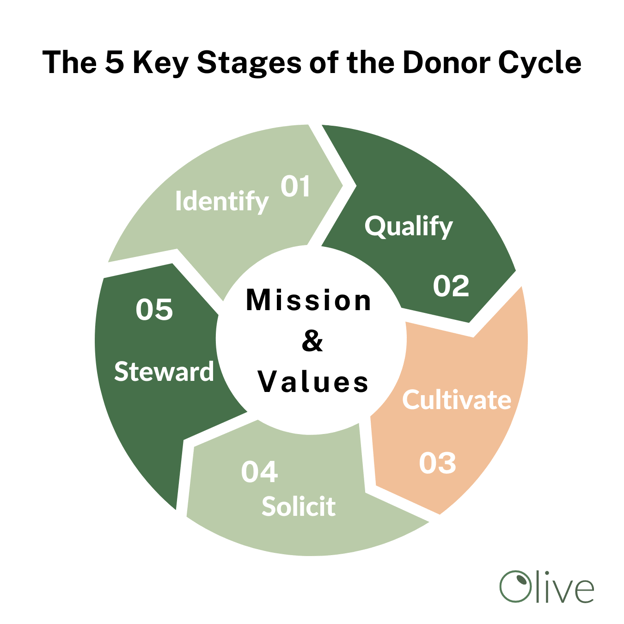In the realm of fundraising, cultivating strong relationships with donors is the ultimate key to success. It's like tending to a flourishing garden, carefully nurturing each seed of generosity until it blossoms into a fruitful partnership. But how do we navigate this intricate cycle and unlock the full potential of donor engagement?
Prepare to embark on a captivating journey as we unveil the five pivotal stages that pave the way to fundraising triumph. From planting the seeds of connection to reaping the bountiful rewards, this article will serve as your guide to mastering the art of donor cultivation.
So, let's put on our metaphorical gardening gloves and dig deep into the fertile soil of philanthropy, where meaningful relationships and impactful giving sprout abundantly.
What is the donor cycle?
At its core, the donor cycle is a strategic method to foster closer relationships between fundraisers and donors. It encompasses a sequence of processes and actions aimed at connecting donors with their values and the fundraising organization.
Imagine a lush garden tended by a skilled gardener. Similarly, in the realm of fundraising, the donor cultivation cycle acts as that green thumb, carefully nurturing the relationship between donors and fundraising organizations. Like a seasoned gardener, fundraisers strategically guide donors through a sequence of stages, creating an environment where their values and aspirations can take root and flourish.
While various representations of the donor cycle exist in fundraising literature, with different numbers of steps, it remains a valuable tool for organizing an overview of the fundraising process and providing a path forward for fundraisers. Organizations may adapt the cycle to suit their specific needs and circumstances.

The 5 stages of the donor cycle
Stage 1 - Identify
Fundraisers begin by identifying high-potential donor prospects, much like a gardener selects the finest seeds. By understanding the trends and commonalities among prospective donors, organizations can better target their efforts and resources.
Existing donor data, such as demographics and qualitative information obtained through feedback and surveys, can provide valuable insights to inform this stage.
Stage 2 - Qualify
Not every prospective donor will be ready or able to contribute. Similar to assessing the soil's suitability for growth, fundraisers must delve deeper to qualify potential donors based on factors such as their interest in the organization's mission, shared values, donation history, and capacity to give. This stage allows fundraisers to prioritize their efforts and focus on engaging those with the highest potential for meaningful involvement.
Stage 3 - Cultivate
Once high-potential donors have been identified and qualified, fundraisers embark on the cultivation stage. Just as a gardener tenderly tends to young shoots, fundraisers nurture relationships with donors through personalized experiences, tailored communications, and opportunities for involvement. By effectively communicating the organization's mission, goals, and impact, fundraisers cultivate a sense of connection, trust, and commitment.
To do this, fundraisers must communicate and educate. Inform donors about your mission and the goals you’re trying to accomplish. Talk to them about the work you’ve done and the impact you’ve had. Do this through your website, emails, phone calls, social media, events and partnerships.
In the process, you may find out information that helps your organization better position itself. Perhaps there’s a program that more people identify with, maybe there’s a particular fundraising event that your donors want to engage with - remember that communication is always multi-sided!
Stage 4 - Solicit
When the time is right, fundraisers transition to the solicitation stage, where they make a compelling case for support. Similar to harvesting the ripe fruits of their labor, fundraisers articulate the impact that a donor's contribution can make.
There are many effective ways of asking for donations - and some of these strategies may be more relevant than others. Whichever one you choose, remember to ask yourself the following questions:
- Are you targeting a decision-maker (someone who can make a financial decision?)
- Are you specific and direct with the action you’re asking of the prospective?
- Are you conveying the right tone as well as the right message?
- Are you asking at the right time with the right channel?
- Are you making it easy to give?
Stage 5 - Steward
The journey does not end with a donation. Just as a gardener tends to the garden beyond the harvest, fundraisers recognize the importance of stewardship. By expressing genuine gratitude, providing transparent updates, and demonstrating the impact of the donor's support, fundraisers cultivate a culture of appreciation and foster long-term relationships.
It is much easier to retain a donor than to obtain a new one. Recurring donations provide financial stability for fundraisers, and allow them to strengthen and build programs.
To steward effectively, make sure you:
- Make it easy to give (roundups and matching can be easy and effective methods of power recurring donations - read more in our other article here)
- Show appreciation with thank-you letters and messages
- Don’t annoy givers with low-quality, high-frequency messaging
- Share progress and updates - be visual and interactive where possible!
Embrace the donor cycle
By embracing the donor cycle, fundraisers can transform their approach to fundraising. They move away from a transactional mindset toward a more holistic, garden-like perspective. They create an environment where donors can flourish, their values align with the organization, and their contributions bloom into meaningful impact.
So, let us embrace the role of gardeners of philanthropy, carefully tending to the donor cultivation cycle, and watch as generosity blossoms.
To easily implement real-time roundups, matching and cashback rewards in your fundraising, chat with us here.